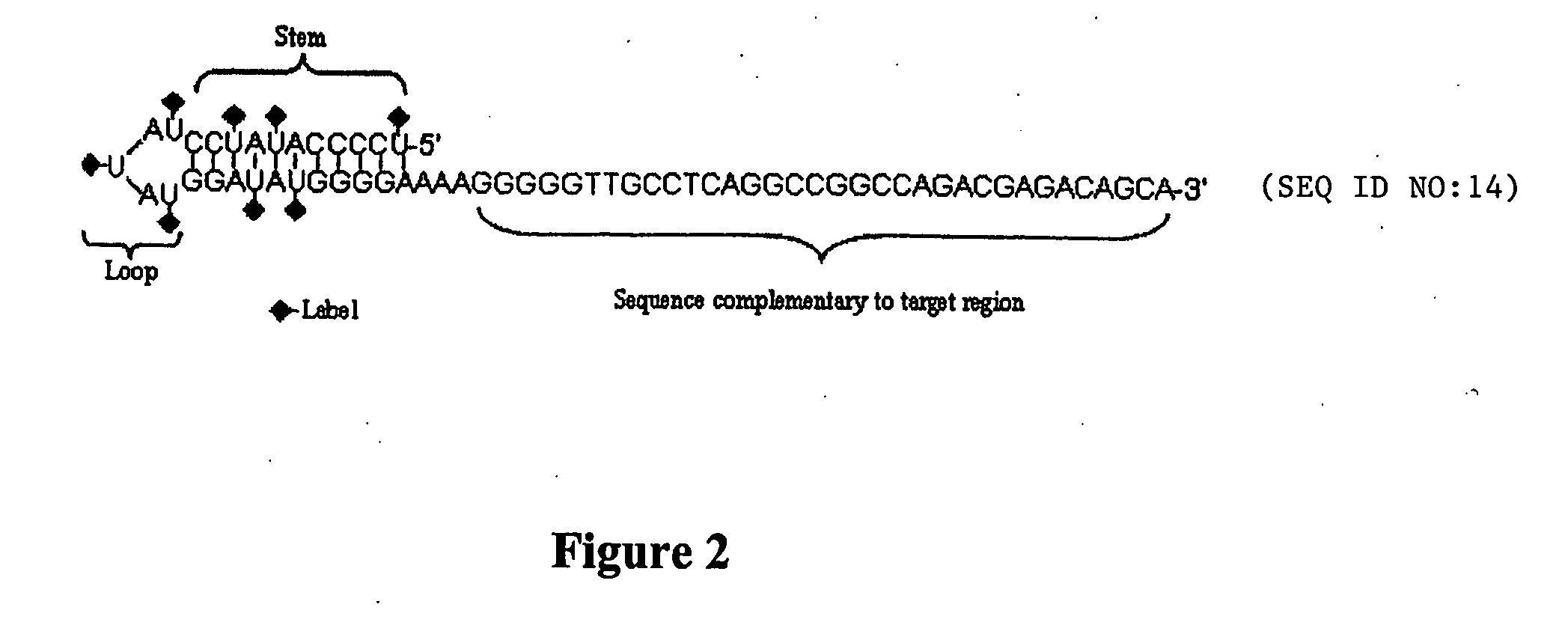Hairpin-labeled probes and methods of use
a technology of probes and hairpins, applied in the field of hairpin-labeled probes and methods of use, can solve the problems of compromising the ability to detect low levels of target nucleic acids in various applications, current detection probes and methods, and oligonucleotide probes cannot be easily labeled using chemical methods
- Summary
- Abstract
- Description
- Claims
- Application Information
AI Technical Summary
Benefits of technology
Problems solved by technology
Method used
Image
Examples
example 1
Detection of EBV EBER-1 RNA Using Hairpin-Labeled Oligonucleotides
[0103] Unless otherwise stated, all reagents are from Sigma-Aldrich Chemical, St. Louis, Mo. Equivalent reagents from sources other than those listed herein can also be used.
[0104] Cell Lines and Cell Culture Conditions
[0105] EBV-positive human RAJI cells and EBV-negative human RL and HL-60 cell lines were obtained from ATCC (Rockville, Md.) and cultured in RPMI 1640 medium supplemented with 2.0-4.5 g / l glucose, 2 mM L-glutamine and 10%-15% fetal bovine serum. Using PCR analysis, we confirmed that both RL and HL-60 lines are EBV-free. Raji cells contain approximately 50 copies of episomal EBV, and express EBER-1 RNA (Stevens et al. J. Clin. Microbiol. 37:2852-2857, 1999).
[0106] Cell Fixation
[0107] Cell fixation is required to maintain cellular structure, and retain target nucleic acids. Cell fixatives, such as HistoChoice-MB have been designed for molecular biology applications such as Fluorescent In Situ Hybridi...
example 2
Detection of HIV RNA Using Hairpin-Labeled Oligonucleotides
[0120] Materials and Methods
[0121] Unless otherwise noted, all reagents are from Sigma-Aldrich Chemical, St. Louis, Mo. Equivalent reagents from sources other than those listed herein can also be used.
[0122] Cells
[0123] OM10.1 cells, latently infected with HIV-1, are used to detect HIV-RNA expressed in cells. HL-60, human promyelocytic leukemia cells, used to generate OM10.1 cells, are used as control cells. Expression of HIV RNA in OM10.1 cells is induced with 20 U / ml of TNFα for 16 hours. Peripheral blood mononuclear cells are isolated from human blood collected in either K3EDTA or citrate Vacutainer (Becton and Dickinson) tubes using Ficoll-Paque Plus (Amersham Biosciences) density gradient. Blood from HIV infected humans is obtained from Mass. General Hospital (Boston, Mass.) or Research Sample Bank (Pompano Beach, Fla.). If fresh blood is not used, complete removal of granulocytes is aided with use of RosetteSep™ (S...
PUM
| Property | Measurement | Unit |
|---|---|---|
| pH | aaaaa | aaaaa |
| Tm | aaaaa | aaaaa |
| Tm | aaaaa | aaaaa |
Abstract
Description
Claims
Application Information
 Login to View More
Login to View More - R&D
- Intellectual Property
- Life Sciences
- Materials
- Tech Scout
- Unparalleled Data Quality
- Higher Quality Content
- 60% Fewer Hallucinations
Browse by: Latest US Patents, China's latest patents, Technical Efficacy Thesaurus, Application Domain, Technology Topic, Popular Technical Reports.
© 2025 PatSnap. All rights reserved.Legal|Privacy policy|Modern Slavery Act Transparency Statement|Sitemap|About US| Contact US: help@patsnap.com



